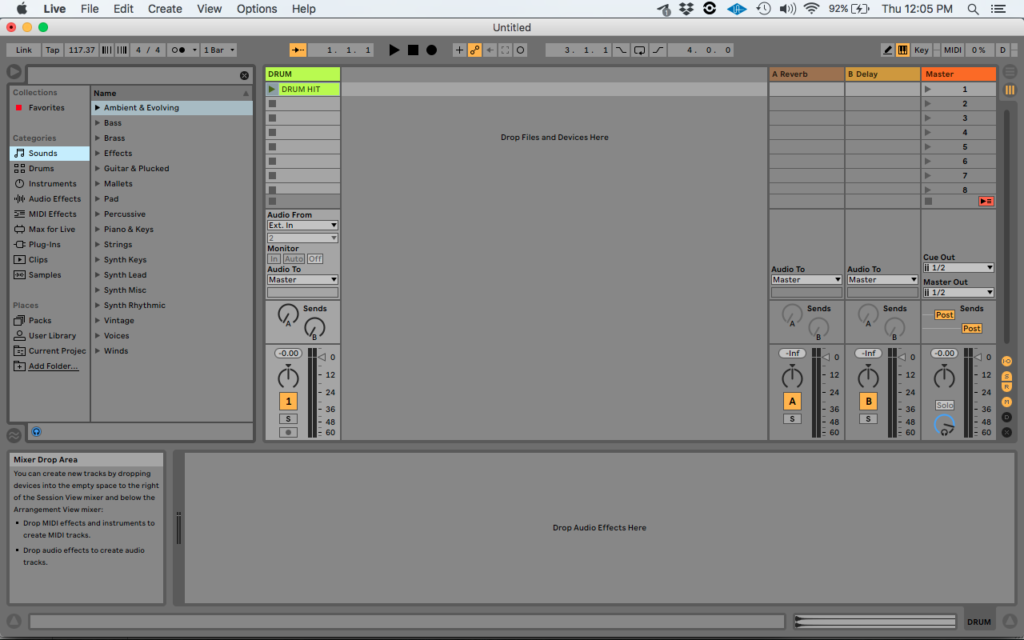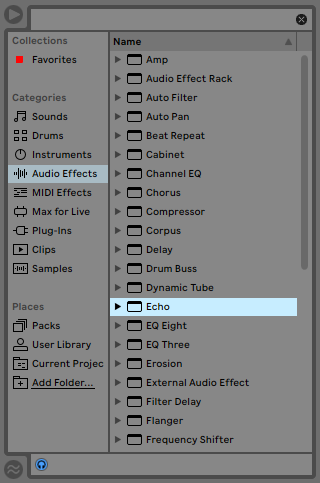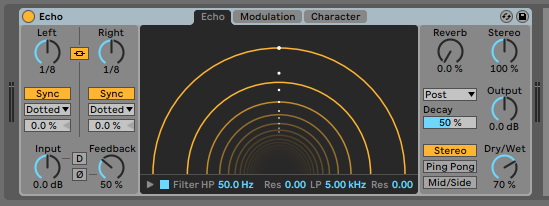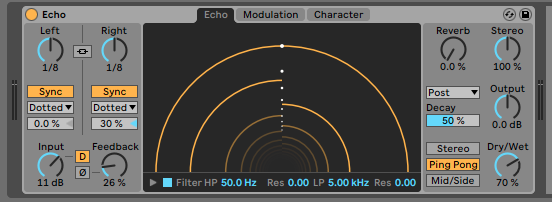This tutorial shows the user how to use the Ableton Live ECHO audio effect.
Need a Pro Audio laptop to run Ableton Live software and all of its features at its best? Check out the MC Mobile line of Pro Audio Laptops from PCAudioLabs.
On the modern days of audio mixing, the digital tools that engineers use in order to shape the recorded sound are called Plugins. Plugins can emulate the behavior of vintage analog pieces of gear, or simply act as clean/linear digital signal processors, performing tasks such as equalization, compression, limiting, expansion, gating, time-domain effects, etc. Ableton Live comes with a variety of proprietary plugins (effects) that can help the user mix a music production completely “in-the-box”.
One of the most used audio effects that come with Ableton Live is ECHO , which can be defined as a device that resembles a modulation delay effect that lets the user set two independent delay lines with different delay times, while controlling envelope and filter modulation. This effect can be set to three different modes called Ping Pong, Stereo and Mid/Side.
For the purpose of this tutorial, we will explain how to use the ECHO audio effect in Ableton Live 10:
- Create a Live Set with at least one audio track. Make sure the audio track has at least one audio clip assigned to it.

2. From the Browser, search for Audio Effects -> Echo:
3. Drag and Drop the Echo audio effect on top of the audio track.
As soon as this effect has been dropped on top of the track, it is easy to see how the Echo audio effect now appears on the device view of the track.
It is easy to see from the previous picture, the Echo audio effect has several parameters that can be explained as:
- Delay Mode: This button toggles between a beat-synced and time-based delay modes.
- Sync Mode: This dropdown list lets the user select between the different sync modes, which are Notes, Dotted, Triplet, 16th.
- Delay Offset: This slider shortens the delay times by fractional amounts.
- Delay Divisions/Delay Time: These two knobs (one for each delay line) can set the delay time of each channel using beat subdivisions (if the delay mode is set to Sync) or using milliseconds (if the mode is set to Time).
- Stereo Link: When this button is enabled, the delay times of both channels are linked.
- Input Gain: This knob sets the amount of gain applied to the input of the device.
- Clip Dry: When this button is ON, the gain will be applied to the dry signal as well, yielding a more analog-distortion effect.
- Feedback: This knob sets the amount of each channel’s output that is being fed back to its input.
- Feedback Invert: When this button is ON, the device will invert the feedback signal before adding it back to the input.
- Filter ON: When this button is ON, the filter gets activated.
- HP Frequency: This adjusts the cutoff frequency of the high pass filter.
- HP Res: This control can adjust the resonance of the High Pass filter applied.
- LP Freq: This adjusts the cutoff frequency of the low pass filter.
- LP Res: This control can adjust the resonance of the Low Pass filter applied.
- Reverb: This knob sets the amount of reverberation added to the effect.
- Stereo Width: This knob controls the stereo width of the wet signal. 0% yields a mono signal, while values above 100% yield exaggerated stereo effects.
- Reverb Location: This dropdown lists lets the user select the location in the processing chain where the reverb will be added. Options include, PRE, POST, FEEDBACK.
- Reverb Decay: This slider controls the length of the reverb tail.
- Output: This knob controls the output gain of the effect.
- Channel Mode: These buttons let the user select between Ping Pong, Stereo and Mid/Side modes.
- Dry/Wet: This knob controls the balance between the affected and unaffected signals.
For the purpose of this tutorial, we will use the Echo audio effect to create a distorted Ping-Pong echo feel. The Echo audio effect will be set as:
- Delay Mode: Sync.
- Sync Mode: Dotted.
- Delay Offset: 0% Left, 30% Right.
- Delay Divisions/Delay Time: 1/8 on both channels.
- Stereo Link: ON.
- Input Gain: 11 dB.
- Clip Dry: ON.
- Feedback: 26%.
- Feedback Invert: OFF.
- Filter ON: ON.
- HP Frequency: 50 Hz.
- HP Res: 0.
- LP Freq: 5 KHz.
- LP Res: 0.
- Reverb: 0%.
- Stereo Width: 100%.
- Reverb Location: Post.
- Reverb Decay: 50.
- Output: 0 dB.
- Channel Mode: Ping Pong.
- Dry/Wet: 70%.
4. Apply the previous configuration, and the Echo audio effect should look like this:
At this point we have successfully explained how to use and configure the Echo audio effect in Ableton Live 10. The tutorial has now finished.
Using Ableton Live 10 software to produce music would be ideal with one of our professionally designed PCAudioLabs Systems due our high-performance specifications in order to work with any of the Digital Audio Workstations supported. If you would like to order one of our PCAudioLabs computers, please call us at 615-933-6775 or click this link for our website.



